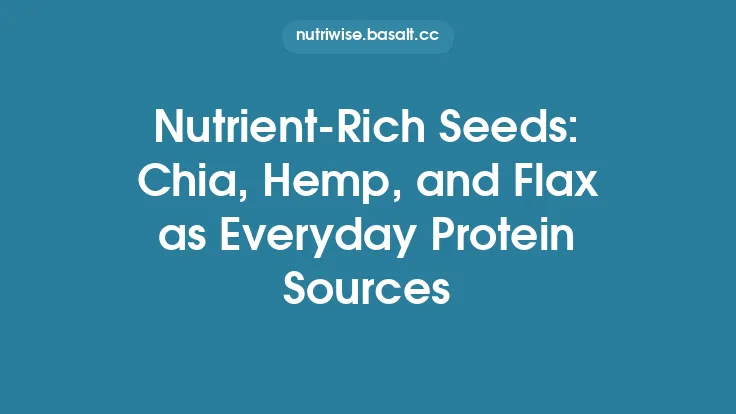Plant‑based protein blends give you the freedom to tailor nutrition, flavor, and texture to the exact needs of your kitchen. Whether you’re looking to power a post‑workout smoothie, add a protein boost to a batch of muffins, or create a portable snack that keeps you satisfied between meals, a well‑crafted DIY blend can be more economical, fresher, and more adaptable than any pre‑made commercial powder.
Why Create Your Own Plant‑Based Protein Blend
- Control Over Ingredients – You decide which protein sources, sweeteners, and additives make the cut, eliminating unwanted fillers, artificial flavors, or excess sugars that often hide in store‑bought products.
- Cost Efficiency – Bulk raw ingredients such as roasted legumes, nut flours, and seed meals are typically cheaper per gram of protein than branded powders.
- Tailored Nutrition – By mixing complementary protein sources you can approach a more complete amino‑acid profile, adjust fiber content, or boost specific micronutrients (iron, calcium, magnesium) without relying on a single “super‑food.”
- Sustainability – Sourcing locally grown beans, grains, or nuts reduces the carbon footprint associated with long‑haul shipping of processed powders.
Key Considerations When Formulating a Blend
- Protein Density – Aim for 60–80 % protein by weight in the final powder. This range provides a solid protein boost while leaving room for functional add‑ins (fiber, fats, flavor).
- Digestibility – Some plant proteins contain antinutrients (phytates, trypsin inhibitors) that can impair absorption. Techniques such as roasting, sprouting, or enzymatic treatment improve digestibility.
- Flavor Balance – Raw legume flours can taste earthy or bitter. Pair them with naturally sweet or aromatic ingredients (coconut sugar, vanilla bean powder, cinnamon) to mask any off‑notes.
- Texture – Fine, uniformly milled powders blend more smoothly. Coarse particles may cause gritty textures in drinks but can be desirable in baked goods for a “crunchy” bite.
- Allergen Management – If you or your audience have nut or seed sensitivities, select alternative protein bases (e.g., oat protein, pumpkin seed meal) and keep cross‑contamination risks low.
Base Ingredients: Protein‑Rich Powders
| Ingredient | Approx. Protein (g) per 100 g | Notable Traits |
|---|---|---|
| Roasted Chickpea Flour | 22 | Mild, nutty flavor; high in fiber |
| Brown Rice Protein Isolate | 80 | Very neutral taste; hypoallergenic |
| Pumpkin Seed Meal | 30 | Slightly sweet, rich in magnesium |
| Sunflower Seed Protein | 45 | Light, buttery flavor; good vitamin E source |
| Oat Protein Concentrate | 55 | Creamy mouthfeel; contains β‑glucan |
| Lentil Flour (sprouted & dried) | 24 | Earthy, high lysine content |
A practical starting point is a 2:1:1 ratio of a high‑protein isolate (brown rice) to two complementary whole‑food powders (chickpea flour and pumpkin seed meal). Adjust the proportions based on the desired flavor profile and protein density.
Supporting Ingredients: Fiber, Healthy Fats, and Flavor Enhancers
- Soluble Fiber – Psyllium husk (2 % of blend) improves mouthfeel in smoothies and helps retain moisture in baked goods.
- Healthy Fats – Ground flaxseed (optional, 3 % of blend) adds omega‑3s and a subtle nuttiness without overwhelming the protein content.
- Natural Sweeteners – Coconut sugar, monk fruit extract, or a pinch of stevia can be added at 1–2 % to balance bitterness.
- Flavor Powders – Vanilla bean powder, cacao nibs, matcha, or dried fruit powders (e.g., freeze‑dried strawberry) provide color and taste without extra liquid.
Balancing Amino Acids Without Repeating Full Profiles
While a complete amino‑acid profile is a hallmark of animal proteins, plant blends can approach completeness by pairing sources that complement each other’s limiting amino acids. Rather than detailing the exact profiles (which would overlap with the “Amino Acid Profiles” article), consider these practical rules:
- Lysine‑Rich + Methionine‑Rich – Legume‑based flours (chickpea, lentil) are high in lysine but low in methionine; seed meals (pumpkin, sunflower) supply the missing sulfur‑containing amino acids.
- Diversify Grain‑Based Proteins – If you include oat protein, pair it with a legume flour to offset the lower lysine content of oats.
A simple “test blend” of 40 % brown rice protein, 30 % chickpea flour, and 30 % pumpkin seed meal typically yields a well‑rounded amino‑acid distribution for most active adults.
Processing Techniques to Improve Digestibility and Shelf Life
- Roasting – Lightly roast legumes and seeds (150 °C for 10–12 min) to deactivate trypsin inhibitors and reduce phytic acid.
- Sprouting – Soak beans or grains for 8–12 h, drain, and allow to sprout for 24–48 h before drying and grinding. Sprouting increases bioavailability of minerals and reduces antinutrients.
- Fine Milling – Use a high‑speed grinder or a micronizing mill to achieve particle sizes <200 µm. This step is crucial for smooth beverage integration.
- De‑fatting (optional) – For seed meals, a brief cold‑press can remove excess oil, extending shelf life and preventing rancidity.
- Packaging – Store the finished blend in airtight, opaque containers with a desiccant packet. Keep in a cool, dark pantry; the blend remains stable for 6–9 months.
Storage Guidelines and Shelf Stability
| Storage Condition | Expected Shelf Life |
|---|---|
| Room temperature, airtight, dark | 6–9 months |
| Refrigerated (≤4 °C) | Up to 12 months |
| Freezer (≤‑18 °C) | Indefinite, but texture may change after thawing |
Always check for off‑odors or clumping before use. If the blend has absorbed moisture, spread it thinly on a baking sheet and dry at 50 °C for 15 min before resealing.
Smoothie Blends: Recipes and Tips
1. Morning Green Power Smoothie Mix (Protein % ≈ 70)
*Base*: 40 g brown rice protein, 30 g chickpea flour, 30 g pumpkin seed meal
*Add‑ins*: 5 g powdered spinach, 2 g vanilla bean powder, 2 g coconut sugar
Method: Blend 2 Tbsp of the mix with 250 ml almond milk, a handful of frozen mango, and a drizzle of almond butter. Adjust liquid for desired thickness.
2. Chocolate‑Banana Recovery Shake
*Base*: 35 g oat protein concentrate, 35 g roasted lentil flour, 30 g sunflower seed protein
*Add‑ins*: 5 g cacao nib powder, 2 g freeze‑dried banana powder, 2 g stevia
Method: Combine 3 Tbsp of blend with 300 ml oat milk, one ripe banana, and a scoop of natural peanut butter. Blend until silky.
3. Tropical Immunity Boost
*Base*: 45 g brown rice protein, 25 g chickpea flour, 30 g pumpkin seed meal
*Add‑ins*: 5 g freeze‑dried pineapple powder, 2 g ginger powder, 2 g monk fruit blend
Method: Mix 2 Tbsp blend with 250 ml coconut water, a handful of frozen pineapple, and a squeeze of lime. Serve chilled.
*Tip*: For ultra‑smooth drinks, pre‑sift the protein blend through a fine mesh to eliminate larger particles.
Baking Blends: Recipes for Muffins, Pancakes, and Energy Bars
1. High‑Protein Banana‑Nut Muffins
*Blend*: 30 g brown rice protein, 30 g chickpea flour, 20 g pumpkin seed meal, 10 g oat protein
*Other Ingredients*: 2 ripe bananas, 2 eggs (or flax “egg” for vegan), 60 ml maple syrup, 60 ml olive oil, 1 tsp baking soda, ½ tsp cinnamon, ½ tsp salt, ½ cup chopped walnuts.
Method: Whisk wet ingredients, then fold in the dry blend. Spoon into a muffin tin and bake at 180 °C for 20–22 min. Each muffin delivers ~12 g protein.
2. Protein‑Packed Pancake Batter
*Blend*: 40 g oat protein concentrate, 30 g brown rice protein, 20 g pumpkin seed meal, 10 g coconut sugar.
*Other Ingredients*: 250 ml soy‑free milk, 1 Tbsp apple cider vinegar (to create “buttermilk”), 1 tsp vanilla extract, 1 tsp baking powder.
Method: Combine wet and dry components, let rest 5 min, then cook on a lightly oiled skillet (2‑3 min per side). Serve with fresh berries and a drizzle of almond butter.
3. No‑Bake Energy Bars
*Blend*: 35 g brown rice protein, 35 g pumpkin seed meal, 30 g sunflower seed protein.
*Other Ingredients*: 120 g dates (pitted), 60 g almond butter, 30 g unsweetened shredded coconut, 1 tsp sea salt, 1 tsp cinnamon.
Method: Pulse dates in a food processor until a paste forms. Add almond butter, blend, then incorporate the protein blend and remaining ingredients. Press into a parchment‑lined pan, refrigerate 1 h, then cut into 12 bars (~10 g protein each).
Snack Mixes and On‑the‑Go Protein Bites
Savory Roasted Chickpea‑Seed Mix
- 50 g roasted chickpea flour (lightly toasted)
- 30 g pumpkin seed meal
- 20 g sunflower seed protein
- 1 tsp smoked paprika, ½ tsp garlic powder, pinch of sea salt
Toss all dry ingredients with a drizzle of olive oil, spread on a baking sheet, and roast at 150 °C for 12 min. Cool and store in a zip‑lock bag for a crunchy, protein‑dense snack.
Sweet Coconut‑Cacao Bites
- 40 g brown rice protein
- 30 g oat protein
- 20 g shredded coconut
- 10 g cacao nib powder
- 2 Tbsp maple syrup, 1 Tbsp coconut oil
Mix dry ingredients, melt syrup and oil together, combine, roll into 1‑inch balls, and chill until firm. Each bite supplies ~8 g protein and a burst of chocolate flavor.
Customizing Blends for Specific Dietary Needs
| Goal | Suggested Adjustments |
|---|---|
| Higher Fiber | Increase psyllium husk or add finely ground oat bran (up to 5 % of total). |
| Lower Fat | Reduce seed meals, replace with additional rice protein isolate. |
| Gluten‑Free | Ensure all grains used are certified gluten‑free (brown rice, oat protein from a gluten‑free source). |
| Kid‑Friendly Sweetness | Add a modest amount of natural fruit powders (apple, pear) and keep the protein density around 50 % to avoid a chalky mouthfeel. |
| Allergen‑Free (nuts & soy) | Stick to rice, chickpea, pumpkin, and sunflower bases; avoid almond butter or soy‑derived additives. |
Troubleshooting Common Issues
| Symptom | Likely Cause | Remedy |
|---|---|---|
| Gritty texture in drinks | Particle size >200 µm or insufficient liquid | Re‑mill the blend, increase liquid ratio, or pre‑sift before use. |
| Bitter aftertaste | Over‑roasted legumes or high proportion of seed protein | Reduce roasting time, add a touch more natural sweetener, or increase vanilla/fruit powders. |
| Clumping in storage | Moisture ingress | Store with a desiccant, keep container sealed, and consider adding a small amount of maltodextrin (2 %) as an anti‑caking agent. |
| Rancid smell | Excess oil from seed meals not fully de‑fatted | Use a cold‑press to remove oil, or keep the blend refrigerated. |
| Flat flavor in baked goods | Insufficient leavening due to high protein load | Add an extra ½ tsp baking powder per cup of flour‑equivalent blend, or incorporate a small amount of starch (e.g., tapioca) to lighten the batter. |
Making Your Blend a Kitchen Staple
- Batch‑Prep Once, Use Daily – Allocate a weekend hour to roast, mill, and combine your chosen ingredients. Portion the blend into 250 g jars for quick grab‑and‑go use.
- Label Clearly – Include protein content per serving, date of production, and any allergen warnings.
- Iterate – Keep a simple log of how each recipe performed (taste, texture, satiety). Small tweaks—like a pinch more cinnamon or a dash of lemon zest—can transform a good blend into a favorite.
By mastering the fundamentals of ingredient selection, processing, and flavor balancing, you’ll have a versatile, nutrient‑dense protein blend that can be dropped into a smoothie, folded into batter, or sprinkled over a snack mix at a moment’s notice. The result is not just a healthier plate, but a more conscious, cost‑effective, and enjoyable approach to sustainable, plant‑based eating.





